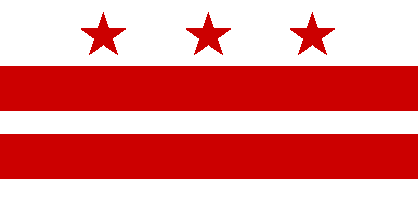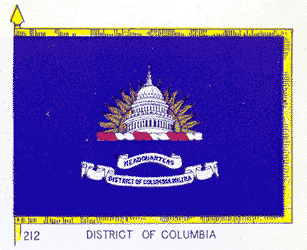
This page is part of © FOTW Flags Of The World website
District of Columbia (U.S.)
Washington, D.C.
Last modified: 2009-07-26 by rick wyatt
Keywords: district of columbia | united states | washington dc |
Links: FOTW homepage |
search |
disclaimer and copyright |
write us |
mirrors
 image by António Martins-Tuválkin, 12 June 2008
image by António Martins-Tuválkin, 12 June 2008
See also:
Description of the Flag
On June 16, 1938, Congress passed Public Law 650 authorizing a flag commission "to procure a design for a distinctive flag for the District of Columbia." The commission consisted of the following:
- Melvin C. Hazen, President of the Board of Commissioners
- the Secretary of War, represented by Captain A. D. Hopping of the office of the Quartermaster General
- the Secretary of the Navy, represented by Lt. J.W. Murphy, Jr., Office of Naval Communications
Assisting the commission were:
- A. F. DuBois, Heraldic Section, Quartermaster Corps;
- G. M. Thornett, Secretary of the Board of Commissioners; and the Commission on Fine Arts.
A flag contest was announced to secure a design. On October 15, 1938, the design made by Charles A. R. Dunn was selected for the flag of the District of Columbia. Dunn had first become interested a flag for DC in 1917. At the time
he was employed to do graphics work for the Thomson-Byron-Ellis Company, specifically working on putting together U.S. state flag designs under the direction of Lt. Commander Byron McCandless. This work would become the October 1917 Flag Number of the National Geographic. In this work, the District of Columbia was represented by the DC National Guard flag.
In reviewing the state flags, Dunn was impressed by the flag of Maryland and not impressed by the flags of states that depicted their seals on the flag. Dunn would soon enlist in the Army and it would not be until he returned in 1921 that he drew up a flag proposal, consisting of the coat-of-arms of George Washington (two red bars and three red stars on a white field).
In 1924, there was a brief push to adopt a flag for the District of Columbia. Although short-lived, the Evening Star newspaper published at least two of the proposals it had received. The first, on February 20, was sent by John Mackaye Dunbar and featured the shield of the arms on a red-white-blue field. Although Dunn's proposal was received prior to February 20, it was not published until March 15 and was different from his original drawings in that he used cobalt
blue for the stars instead of red.
The DC Flag Commission decided to include in its search all proposals received prior to 1938 as well as new selections. Dunn sent in his 1921 red-star proposal. The chart he provided also depicted ways the flag could be used in designing flags for local governmental agencies as well as civic organizations.
On August 24, the Evening Star reported that the Flag Commission was deadlocked between two designs: Dunn's and a proposal by Mrs. George T. Hawkins. Mrs. Hawkins' proposal featured a large star (color not specified in the article) on a blue field, surrounded by 48 gold stars. The large star would be divided into 13 parts representing the original colonies and would feature in the center either the U.S. Capitol Building or the shield of the Washington coat-of-arms. The Evening Star also cited that the Commission made "no claim that the flag was the work of A. E. DuBois" or Captain Hopping. The two
proposals were made into flags and the selection made by the Flag Commission was with the advice of the Commission on Fine Arts. The flag was first hoisted at the International Horse Show held in Washington in October, 1938 by Commissioner Hazen.
Annotated bibliography:
- Charles A. R. Dunn, The Origins of the District of Columbia Flag, Records of the Columbia Historical Society of Washington, DC, 1957-59 (1961), pp. 82-86 with unpaginated plate.
(Includes extensive quotes from the Evening Star. Note: the Evening Star went out of business and its assets were purchased by the Washington Post.)
- Government of the District of Columbia, untitled monograph, 1963, pp. 21-23.
(An unnumbered page in my photocopy of the relevant pages shows the first hoisting and enumerates the members of the Flag Commission. Additional pages in the copy include the DC Flag Protocol.)
Construction Details
The 1938 District of Columbia Flag Commission developed the following
specification:
"The proportions of the design are prescribed in terms of the hoist, or vertical height, of the flag as follows: the upper white portion shall be 3/10 of the hoist; the two horizontal bars are each 2/10 of the hoist; the white are between the bars 1/10 of the hoist; and the base, or lowest white space, is 2/10 of the hoist. The three five-pointed stars have a diameter of 2/10 of the hoist and are spaced equidistant in the fly, or horizontal, dimension of the flag."
Source: Government of the District of Columbia, untitled monograph, 1963, pp. 21-23.
Phillip L. Nelson, 17 September 2002
Prior D.C. flags
Flag in 1937 National Geographic Magazine
 image by Steve Stringfellow
image by Steve Stringfellow
The National Geographic magazine of 1937 shows this flag. The description in the magazine is as follows:
"In the absence of any official flag for the District of Columbia, the District Militia devised the one reproduced here, and until such time as it shall be replaced by law, it will be the flag of the District of Columbia, just as
formerly the one with the hatchet has that status."
Steve Stringfellow, 13 August 2002
The device on the center (the Capitol dome in front of a rising sun) is still the crest used on coats of arms of units of the District of Columbia Army National Guard. It is, therefore, still flag relevant since it appears on the regimental and battalion colors of such units.
Joe McMillan, 14 August 2002
Flag in 1917 National Geographic Magazine
 image by Dave Martucci, 1 June 1997
image by Dave Martucci, 1 June 1997
Flag as shown in National Geographic Magazine
(1917)
A District
It remains a federal district, separate from the 50 states, just as it was when it was established in the late 1700's. (About 40 square miles were given back to the State of Virginia in the 1840's because they thought that there would never be enough bureaucrats to fill the original 100 square miles. Boy were they wrong!) The District has obtained a certain amount of "home rule" since the 1960's which means that the citizens may elect a Mayor and a City Council, however they have no voting representative in the U.S. Congress.
Nick Artimovich, 20 January 1998
"Bars and Mullets"
George Washington's arms were two horizontal bars on a white field, with three red mullets (5-pointed spur rowels) in the chief. The design is seen on the side of DC official vehicles, on the license plates, etc, and was adopted as the flag of Washington, DC, in 1938. (Ironically, one of the largest examples of this flag flies on Pennsylvania Avenue and is incorrect in that the bottom "white stripe" is missing!) In the 19th century there was a belief that these design elements of G. Washington's arms were the direct antecedent of the U.S. flag. If that were true, then the U.S. flag should be called the "Bars and Mullets" not the "Stars and Stripes."
Technically, the mullets should have holes in the center where they spun on the spur, however I think heraldry has deleted the holes as unnecessary. This means that mullets end up looking exactly like five-pointed stars, which is why folks made the connection between George Washington's arms and the U.S. flag.
Nick Artimovich, 23 January 1997
 image by António Martins-Tuválkin, 12 June 2008
image by António Martins-Tuválkin, 12 June 2008

 image by António Martins-Tuválkin, 12 June 2008
image by António Martins-Tuválkin, 12 June 2008
 image by Dave Martucci, 1 June 1997
image by Dave Martucci, 1 June 1997